Text
The Enchantment of DevOps: Why It Holds Professionals Spellbound
DevOps, a fusion of Development and Operations methodologies, has enchanted tech enthusiasts worldwide. But what exactly instills this fervent devotion to DevOps? Let's delve into the primary factors driving its widespread allure.

1. Enhanced Team Collaboration
DevOps acts as a catalyst for collaboration between development and operations teams, tearing down the barriers that once separated them. Through promoting transparent communication and shared responsibilities, DevOps fosters a collaborative culture where teams unite towards common goals.
2. Accelerated Time to Market
An outstanding feature of DevOps is its ability to expedite the software development lifecycle. By automating processes and implementing continuous integration and delivery (CI/CD) pipelines, DevOps empowers organizations to release software updates swiftly and reliably. This agility in deployment ensures alignment with rapidly evolving customer demands.
3. Elevated Software Quality
DevOps places a premium on automation, continuous testing, and vigilant monitoring throughout the development journey. This emphasis on quality assurance facilitates early detection and resolution of issues, resulting in more robust and dependable software deployments. Consequently, organizations can deliver products of superior quality, surpassing customer expectations.

4. Scalability and Adaptability
DevOps equips organizations with the tools to scale their infrastructure seamlessly and adapt to dynamic business requirements. Leveraging cloud services, infrastructure as code (IaC), and containerization technologies like Docker and Kubernetes, DevOps empowers teams to manage applications efficiently, regardless of scale or complexity.
5. Heightened Operational Efficiency
By streamlining workflows, minimizing manual interventions, and eliminating bottlenecks, DevOps drives operational efficiency. Automation of repetitive tasks and standardization of development environments enable teams to focus their efforts on innovation and value delivery, optimizing resource utilization.
6. Cultivation of Continuous Learning and Growth
At the core of DevOps lies a commitment to continuous learning and growth. By embracing a culture of experimentation, feedback loops, and iterative refinement, teams can identify areas for improvement and implement changes incrementally. This iterative approach fuels innovation and ensures organizational agility and responsiveness to evolving market dynamics.
In Conclusion
In conclusion, DevOps offers a multitude of benefits that resonate with professionals across the software development spectrum. From fostering collaboration and accelerating time to market to enhancing software quality and operational efficiency, DevOps empowers organizations to deliver high-quality software swiftly and efficiently. Embracing the principles and practices of DevOps enables companies to remain competitive in the ever-evolving digital landscape.
0 notes
Text
Navigating Your Path to Becoming a DevOps Engineer
Are you aiming to kickstart your career journey as a DevOps engineer? DevOps stands at the intersection of software development and IT operations, offering a blend of practices that streamline and automate processes. With organizations prioritizing efficient software delivery, the demand for adept DevOps professionals continues to surge. If you're eager to carve your niche in this dynamic field, here's a comprehensive roadmap to help you land your dream DevOps engineer role.

Step 1: Grasp the Core Concepts
Before delving into job applications, it's essential to grasp the core tenets of DevOps. This entails understanding the principles behind continuous integration, continuous delivery, automated testing, and infrastructure as code.
Familiarize yourself with key DevOps tools like Docker, Kubernetes, Jenkins, Ansible, and Git. Leverage online tutorials, courses, and resources to deepen your understanding of these concepts and tools.
Step 2: Refine Your Skill Set
With the fundamentals in place, it's time to hone your skills through practical application. Set up a lab environment on your machine or utilize cloud platforms like AWS, Azure, or Google Cloud to gain hands-on experience in deploying and managing infrastructure.
Engage in projects that involve automating tasks, configuring CI/CD pipelines, and working with containerized applications. Consider pursuing relevant certifications such as AWS Certified DevOps Engineer, Docker Certified Associate, and Certified Kubernetes Administrator to validate your expertise.

Step 3: Gain Practical Experience
Hands-on experience is invaluable in the journey to becoming a proficient DevOps engineer. Seek out opportunities for real-world exposure, whether through internships, freelance projects, or contributions to open-source initiatives.
Immerse yourself in online communities and forums to collaborate with peers, share insights, and stay abreast of industry trends. If you're currently employed in a different IT or software development role, look for opportunities to incorporate DevOps-related tasks into your responsibilities.
Step 4: Showcase Your Accomplishments
As you accumulate experience and refine your skills, build a compelling portfolio to showcase your achievements. This could take the form of a personal website, a GitHub repository, or a polished LinkedIn profile.
Highlight the projects you've worked on, the technologies you've utilized, and the outcomes you've achieved. Tailor your resume and cover letter to emphasize your DevOps expertise, using specific examples to demonstrate your contributions to successful projects.
Step 5: Network Strategically
Networking plays a crucial role in advancing your DevOps career. Attend industry events, meetups, and conferences to connect with professionals in the field. Engage in online communities and forums to expand your network and stay informed about job opportunities.
When applying for DevOps engineer roles, customize your applications to align with each company's culture and requirements. Demonstrate how your skills and experience can contribute to their objectives and success.
Step 6: Prepare for Interviews
Prepare thoroughly for interviews by familiarizing yourself with common DevOps interview questions and scenarios. Be ready to discuss your experience with relevant tools and technologies, as well as your problem-solving abilities and collaborative approach.
During the interview, convey your passion for DevOps and your ability to thrive in a fast-paced, collaborative environment. Highlight your communication skills, adaptability, and commitment to continuous learning and growth.
By following this roadmap and remaining dedicated to your professional development, you can increase your chances of securing a fulfilling DevOps engineer role. Good luck on your journey!
0 notes
Text
Examining the Extent of DevOps: A Thorough Evaluation
In today's ever-evolving technological landscape, DevOps stands out as a pivotal methodology in software development. But what exactly does DevOps entail, and how vast is its impact? Let's delve deeper into the scope of DevOps and explore its various facets.

Defining DevOps
DevOps transcends mere tools or practices; it embodies a cultural shift aimed at closing the gap between development (Dev) and operations (Ops) teams. Its core focus lies in fostering collaboration, communication, and integration among traditionally separate departments to streamline the software delivery process.
Key Principles
DevOps operates on fundamental principles that guide its scope and implementation:
Automation: Automating repetitive tasks, such as testing and deployment, expedites the software delivery pipeline and minimizes manual errors.
Collaboration: Promoting collaboration among development, operations, and other stakeholders fosters shared accountability for the entire software lifecycle.
Continuous Integration/Continuous Delivery (CI/CD): CI/CD practices enable developers to integrate code changes into a shared repository and deliver them reliably to production environments.
Monitoring and Feedback: Continuous monitoring of applications and infrastructure provides insights into performance and user experience, facilitating rapid feedback for improvement.

Scope of DevOps
DevOps encompasses various dimensions within the software development lifecycle:
Development: DevOps practices begin with development, where teams collaborate on coding, testing, and feature implementation to ensure deployable and scalable code.
Testing: Testing is crucial in DevOps, focusing on automation and early defect detection to maintain product quality.
Deployment: DevOps advocates for frequent and predictable deployments through CI/CD pipelines, orchestrated by automation tools.
Operations: In operations, DevOps emphasizes infrastructure as code (IaC) for provisioning and configuring infrastructure through code, supported by monitoring and logging.
Security: Security is paramount in DevOps, with DevSecOps integrating security measures throughout the development lifecycle via automated scans and compliance checks.
Feedback and Continuous Improvement: DevOps fosters a culture of continuous improvement through feedback mechanisms like post-mortems and user analytics, driving iterative enhancements.
Conclusion
In summary, DevOps encompasses the entire software development lifecycle, promoting collaboration, automation, and continuous improvement. By embracing DevOps principles, organizations can accelerate software delivery, drive innovation, and enhance customer satisfaction.
0 notes
Text
Charting Your Path to DevOps Engineering: A Comprehensive Roadmap
1. Grasp the Essential Tenets
Before immersing yourself in the world of DevOps engineering, it's vital to solidify your understanding of fundamental principles and technologies. Familiarize yourself with key components such as version control systems like Git, continuous integration/continuous delivery (CI/CD) pipelines, containerization solutions like Docker, and configuration management tools such as Ansible or Puppet. Additionally, acquaint yourself with the basics of cloud computing services offered by major providers like AWS, Azure, or Google Cloud Platform (GCP), as they serve as the foundation of modern DevOps practices.

2. Refine Your Automation Skills
Automation forms the backbone of DevOps methodologies. Develop proficiency in scripting languages like Python, Bash, or PowerShell to automate routine tasks and streamline processes. Mastery of infrastructure as code (IaC) principles using tools like Terraform or CloudFormation is also essential for automating the provisioning and management of infrastructure resources. The ability to automate deployment pipelines, monitoring processes, and scalability mechanisms is indispensable for a successful DevOps career.
3. Cultivate Practical Expertise
While theoretical knowledge lays the groundwork, practical experience is paramount in the journey to becoming a DevOps engineer. Engage in personal projects or contribute to open-source endeavors on platforms like GitHub to apply theoretical concepts in real-world scenarios and showcase your capabilities to potential employers. Consider participating in hackathons or joining virtual communities to collaborate with peers and gain hands-on experience in deploying and managing applications.
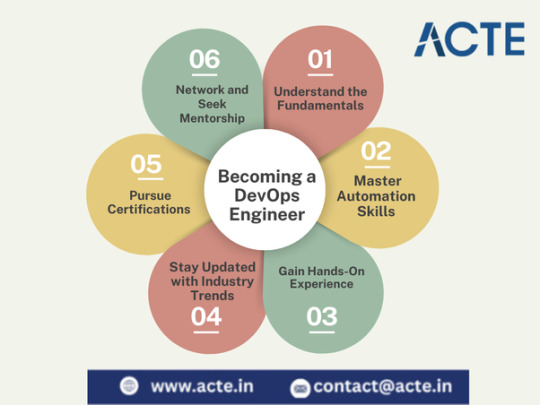
4. Foster Collaboration and Communication
DevOps is as much about people as it is about technology. Cultivate strong interpersonal and communication skills to effectively bridge the gap between development and operations teams. Embrace collaboration, transparency, and empathy to foster strong working relationships with colleagues across different departments.
5. Stay Informed of Industry Trends
The tech landscape evolves rapidly, and staying abreast of the latest trends and advancements is essential for success in DevOps. Keep yourself updated by following industry blogs, attending webinars and conferences, and actively participating in online forums. Continuous learning is key to adapting to emerging technologies and remaining competitive in the job market.
6. Consider Certification Pathways
While not obligatory, certifications can add credibility to your skillset and validate your expertise in DevOps practices. Explore certification options such as AWS Certified DevOps Engineer, Microsoft Certified: Azure DevOps Engineer, or Docker Certified Associate to demonstrate your proficiency in specific platforms and technologies. Certifications signal your commitment to professional development and can enhance your marketability to potential employers.
7. Expand Your Network and Seek Guidance
Networking is instrumental in career advancement, particularly in the DevOps community. Attend industry events, join relevant professional groups, and connect with peers and industry experts on platforms like LinkedIn. Seeking mentorship from experienced DevOps practitioners can provide valuable insights and guidance to navigate your career path effectively.
In Conclusion
Becoming a DevOps engineer requires a blend of technical acumen, practical experience, collaboration, continuous learning, and networking. By mastering automation, understanding core principles, gaining hands-on experience, and staying attuned to industry trends, you can embark on a fulfilling career journey in DevOps engineering. Embrace a growth mindset, remain adaptable, and relentlessly pursue knowledge as you progress toward becoming a proficient DevOps engineer.
0 notes
Text
Exploring the World of Data Analytics: Opportunities and Beyond
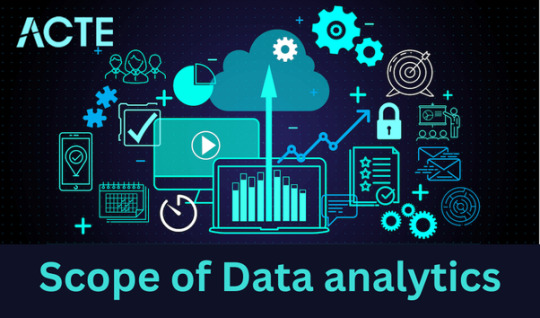
Describe data analytics.
Analyzing data to find useful information, patterns, and trends is known as data analytics. Businesses adore it since it aids in their improvement. It’s similar to solving problems with data.
Why is data analysis so crucial?
Consider yourself in possession of a treasure map (data) and the desire to locate the treasure (insights). Your compass is data analytics.
Why it matters is as follows:
It aids in your understanding of consumer behavior, market trends, and company performance.
Efficiency: You can discover areas in which your company may save both time and money.Smart decisions: When using data, you may base decisions on facts rather than educated guesswork.
Personalization: Have you ever seen how Netflix suggests shows? That is data analysis.
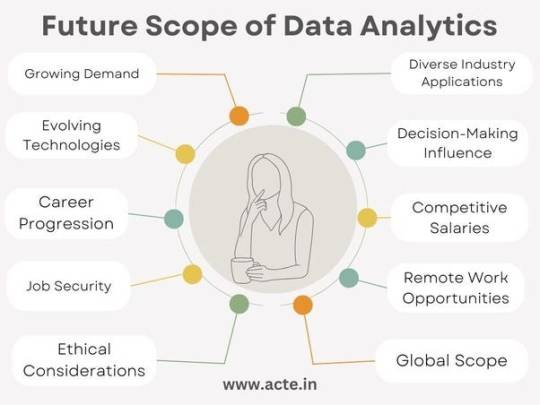
Future Scope of Data Analytics :
High Demand: Many businesses in different industries need data experts because they use data to make smart choices. So, the need for skilled data analysts is growing.
Various Job Fields: Data skills are useful everywhere, not just in one industry. You can work in finance, healthcare, e-commerce, marketing, or technology. This means you have many options for your career.
Tech Keeps Changing: The tools and methods for working with data keep getting better and different. It’s important to keep learning new things, but it also means you can become an expert in a special area.
Helping Decisions: Data people play a big role in helping businesses make important decisions. What you find in data can change how a company plans for the future.
Career Growth: Starting as a data analyst can lead to better and higher-paying jobs like data scientist or machine learning engineer.
Good Pay: Data analysts are paid well. As you get better at your job, you can earn even more.
Job Security: As long as companies use data, they’ll need people who understand it. So, you’ll have a stable job.
Work from Anywhere: You can often do data work from anywhere, giving you flexibility in where you live.
Ethical Data: Data privacy and being fair with data are important. People who can make sure data is used the right way are in demand.
Worldwide Opportunities: Data skills are needed all over the world, so you
can work in different countries if you want.
Careers in Data Analytics:
Data Analyst: The entry point They collect, clean, and analyze data.
Data Scientist: The Experts They use machine learning to solve complex puzzles.
Business Analyst: The bridge between data and business decisions
Big Data Engineer: They manage massive data sets using big data tools.
Healthcare Analyst: They use data to improve healthcare outcomes.
Marketing Analyst: Masters of measuring marketing success
Financial Analyst: They use data for financial strategies.
Sports Analyst: They play with data in the world of sports.
The Future of Data Analytics:
AI and machine learning: Think smarter, not harder. Automation will rule.
IoT Analytics: Connected devices will provide more data than ever.
Ethical Analytics: Data privacy will be a top concern.
Data Visualisation: Making data pretty and easy to understand will be big.
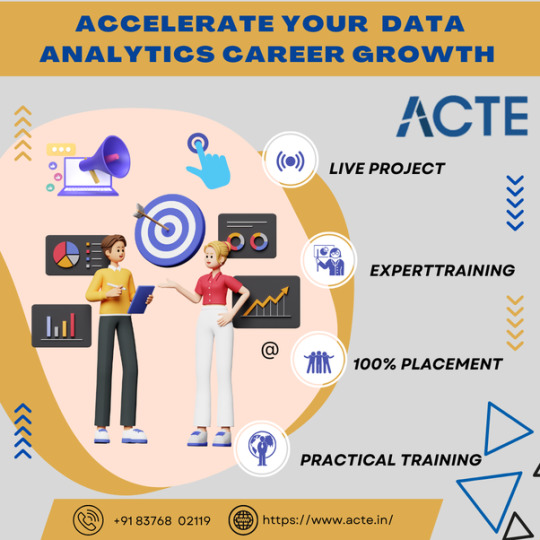
Feel free to get in touch with an ACTE institution if you want to learn more about Data Analytics because they provide certifications and possibilities for job placement. Teachers with experience can improve your learning. These services are available offline and online. Take things slowly and, if you’re interested, think about signing up for a course.
I hope I was able to effectively respond to your query. If it’s not, add it in the comments section. I still think I have a lot to learn.
Consider following me and giving this answer an upvote if you found it to be useful. This will motivate me to post more information on data analytics.
We appreciate you taking the time to read this and voting it up. Enjoy your day.
#data analytics#data analysis#data analytics course#data analyst jobs#data analyst training#data analyst certification#data analyst course
3 notes
·
View notes
Text
No One Will Ever Teach You About Data Analytics in a Very Simple Way with Real-Time Examples
In today's modern digital world, data is all around us. Every time you use your smartphone, buy something online, or share something on social media, you're creating data. But why is data important, and how can we use it to make better decisions? That's where data analytics comes into play, and in this blog, we'll explain it in simple terms.

What is data analytics?
At its core, data analytics is like a detective for the digital world. It's the process of looking closely at data, cleaning it up, changing it into useful information, and figuring out what it tells us. This information helps people and organisations make smart choices, solve problems, and even guess what might happen in the future.
How does data analytics work?
Imagine you run a small ice cream shop in your neighborhood. You sell different flavours, from classic chocolate to unique mango. To run your shop well, you need to make good choices about which flavours to have and when to offer them. That's where data analytics can help, and I'll show you how it works using a simple example.

Data Collection
Every day, you keep a record of which ice cream flavours you sell and keep an eye on the weather. You also note whether it's a regular weekday or a fun weekend.
Data Analysis
After a few months, you have a pile of notebooks filled with sales data. You use a special computer programme to look at all this information.
Descriptive Analytics: You make graphs and charts to see which flavours are liked the most. For instance, you notice that chocolate sells well all year.
Diagnostic Analytics: Digging deeper, you discover patterns, like mango ice cream being a hit on hot weekends and vanilla being popular on weekdays.
Predictive Analytics
Here's where it gets exciting. Using past data, your analytics tool can make guesses. It tells you that the next weekend will be very hot. So, you decide to order more mango ice cream to be ready for the extra demand.
Prescriptive Analytics
Now, it's not just about guessing. You also get advice on what to do. Your analytics tool suggests that during the weekdays, you could offer a discount on vanilla to bring in more customers.
Implementing Changes
You follow the advice and give discounts on vanilla during the weekdays. You also make sure to have plenty of mango ice cream for the upcoming hot weekend.
Seeing Results
When the hot weekend comes, customers are happy to see lots of mango ice cream, and sales go up. On weekdays, the discount on vanilla brings in more customers and boosts sales.
This process keeps going, and you continue using data analytics to make good choices about flavours, discounts, and how much ice cream to have in stock. Your ice cream shop becomes more successful because you're using data to understand what customers like and how the weather affects sales.
In short, data analytics is like having a crystal ball for your business. It helps you understand what happened in the past (descriptive), why it happened (diagnostic), guess what might happen in the future (predictive), and suggest what you should do about it (prescriptive). Whether you run an ice cream shop or a big company, data analytics helps you make smarter decisions in real-time.
If you want to learn more about data analytics or need help using it in your business, you can talk to experts or take specialised courses. For example, ACTE Institute offers comprehensive data analytics training programmes that can give you the knowledge and skills you need, including job placement and certification. So, get ready to learn, explore the tools, and start turning data into valuable insights!
12 notes
·
View notes
Text
From Zero to Hero: Mastering Data Analytics for Transformation

The concept of "data" has enormous significance in the modern digital world. The enormous amount of information produced every day has revolutionized the way we view the world and move through it. The data analytics industry is one of the major players in this revolution. Let's set out on an adventure to discover the fundamentals of data analytics, consider their importance, and understand how they affect different facets of our lives.
Understanding Data Analytics
Analyzing massive data sets to find hidden patterns, correlations, trends, and insights is at the heart of data analytics. It's like sorting through a gold mine of knowledge to find the gold nuggets that will help you make decisions and solve problems. Data analytics isn't just about statistics and figures; it's about turning raw data into compelling narratives that encourage informed decisions.
Why Data Analysis Is Important
The capacity to make sense of all the data in the globe has changed the game. Data analytics enables companies, groups, and people to comprehend their operations, clients, and environments more thoroughly. Here are a few main arguments in favor of data analytics:
Making Informed Decisions: Data-driven insights allow for more precise and knowledgeable decision-making. Companies might modify their tactics in light of current developments and customer preferences.
Enhanced Efficiency: Data analytics uncovers bottlenecks and inefficiencies in processes and operations, allowing for focused changes.
Predictive Skills: By analyzing past data, predictive models can predict future patterns and aid organizations in becoming ready for the future.
Customer insights: Data analytics reveals the preferences and habits of customers, enabling more individualized interactions and higher levels of customer satisfaction.
Risk Management: Identifying potential risks and fraud patterns is made easier with data analytics, reducing vulnerabilities and losses.
Scientific Discoveries: In fields like healthcare and research, data analytics aids in uncovering groundbreaking insights and advancements.
The Data Analytics Process

Data analytics involves a systematic approach that follows several key steps:
Defining Objectives: Clearly state the objectives and issues you hope to resolve through data analysis.
Data Collection: Collect pertinent data from a variety of sources, making sure it is reliable and representative.
Data Cleaning: Involves altering it to ensure accurate analysis.
Exploratory Analysis: Investigate the data in depth to find patterns, trends, and early insights.
Modeling: Building statistical models or algorithms to forecast outcomes or comprehend correlations in the data is known as modeling.
Interpretation: Draw conclusions from your analysis's findings and connect them to your original goals.
Visualization: To make your findings easier to understand, present them using visual tools like charts, graphs, and dashboards.
Action: Implement the learnings from data analysis to inspire positive changes and actions.
Data analytics has become an effective means for turning data into useful insights. By bridging the gap between information overload and useful knowledge, it facilitates decision-making, ignites innovation, and opens doors. A fascinating and fruitful trip may be had by anyone interested in learning more about data analytics, whether they are a business owner, researcher, or just curious. So, take part in uncovering the secrets of the data and grasp the power of data analytics to transform. If you need help implementing data analytics in your organization or if you want to learn more, you should consult professionals or sign up for specialized courses. For instance, the ACTE Institute offers comprehensive data analytics training courses that can provide you the knowledge and skills you need.
7 notes
·
View notes
Text
In the subject of data analytics, this is the most important concept that everyone needs to understand. The capacity to draw insightful conclusions from data is a highly sought-after talent in today's data-driven environment. In this process, data analytics is essential because it gives businesses the competitive edge by enabling them to find hidden patterns, make informed decisions, and acquire insight. This thorough guide will take you step-by-step through the fundamentals of data analytics, whether you're a business professional trying to improve your decision-making or a data enthusiast eager to explore the world of analytics.
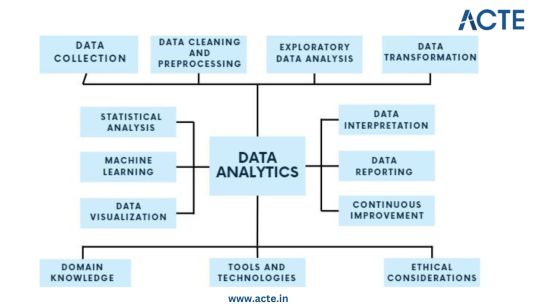
Step 1: Data Collection - Building the Foundation
Identify Data Sources: Begin by pinpointing the relevant sources of data, which could include databases, surveys, web scraping, or IoT devices, aligning them with your analysis objectives.
Define Clear Objectives: Clearly articulate the goals and objectives of your analysis to ensure that the collected data serves a specific purpose.
Include Structured and Unstructured Data: Collect both structured data, such as databases and spreadsheets, and unstructured data like text documents or images to gain a comprehensive view.
Establish Data Collection Protocols: Develop protocols and procedures for data collection to maintain consistency and reliability.
Ensure Data Quality and Integrity: Implement measures to ensure the quality and integrity of your data throughout the collection process.
Step 2: Data Cleaning and Preprocessing - Purifying the Raw Material
Handle Missing Values: Address missing data through techniques like imputation to ensure your dataset is complete.
Remove Duplicates: Identify and eliminate duplicate entries to maintain data accuracy.
Address Outliers: Detect and manage outliers using statistical methods to prevent them from skewing your analysis.
Standardize and Normalize Data: Bring data to a common scale, making it easier to compare and analyze.
Ensure Data Integrity: Ensure that data remains accurate and consistent during the cleaning and preprocessing phase.
Step 3: Exploratory Data Analysis (EDA) - Understanding the Data
Visualize Data with Histograms, Scatter Plots, etc.: Use visualization tools like histograms, scatter plots, and box plots to gain insights into data distributions and patterns.
Calculate Summary Statistics: Compute summary statistics such as means, medians, and standard deviations to understand central tendencies.
Identify Patterns and Trends: Uncover underlying patterns, trends, or anomalies that can inform subsequent analysis.
Explore Relationships Between Variables: Investigate correlations and dependencies between variables to inform hypothesis testing.
Guide Subsequent Analysis Steps: The insights gained from EDA serve as a foundation for guiding the remainder of your analytical journey.
Step 4: Data Transformation - Shaping the Data for Analysis
Aggregate Data (e.g., Averages, Sums): Aggregate data points to create higher-level summaries, such as calculating averages or sums.
Create New Features: Generate new features or variables that provide additional context or insights.
Encode Categorical Variables: Convert categorical variables into numerical representations to make them compatible with analytical techniques.
Maintain Data Relevance: Ensure that data transformations align with your analysis objectives and domain knowledge.
Step 5: Statistical Analysis - Quantifying Relationships
Hypothesis Testing: Conduct hypothesis tests to determine the significance of relationships or differences within the data.
Correlation Analysis: Measure correlations between variables to identify how they are related.
Regression Analysis: Apply regression techniques to model and predict relationships between variables.
Descriptive Statistics: Employ descriptive statistics to summarize data and provide context for your analysis.
Inferential Statistics: Make inferences about populations based on sample data to draw meaningful conclusions.
Step 6: Machine Learning - Predictive Analytics
Algorithm Selection: Choose suitable machine learning algorithms based on your analysis goals and data characteristics.
Model Training: Train machine learning models using historical data to learn patterns.
Validation and Testing: Evaluate model performance using validation and testing datasets to ensure reliability.
Prediction and Classification: Apply trained models to make predictions or classify new data.
Model Interpretation: Understand and interpret machine learning model outputs to extract insights.
Step 7: Data Visualization - Communicating Insights
Chart and Graph Creation: Create various types of charts, graphs, and visualizations to represent data effectively.
Dashboard Development: Build interactive dashboards to provide stakeholders with dynamic views of insights.
Visual Storytelling: Use data visualization to tell a compelling and coherent story that communicates findings clearly.
Audience Consideration: Tailor visualizations to suit the needs of both technical and non-technical stakeholders.
Enhance Decision-Making: Visualization aids decision-makers in understanding complex data and making informed choices.
Step 8: Data Interpretation - Drawing Conclusions and Recommendations
Recommendations: Provide actionable recommendations based on your conclusions and their implications.
Stakeholder Communication: Communicate analysis results effectively to decision-makers and stakeholders.
Domain Expertise: Apply domain knowledge to ensure that conclusions align with the context of the problem.
Step 9: Continuous Improvement - The Iterative Process
Monitoring Outcomes: Continuously monitor the real-world outcomes of your decisions and predictions.
Model Refinement: Adapt and refine models based on new data and changing circumstances.
Iterative Analysis: Embrace an iterative approach to data analysis to maintain relevance and effectiveness.
Feedback Loop: Incorporate feedback from stakeholders and users to improve analytical processes and models.
Step 10: Ethical Considerations - Data Integrity and Responsibility
Data Privacy: Ensure that data handling respects individuals' privacy rights and complies with data protection regulations.
Bias Detection and Mitigation: Identify and mitigate bias in data and algorithms to ensure fairness.
Fairness: Strive for fairness and equitable outcomes in decision-making processes influenced by data.
Ethical Guidelines: Adhere to ethical and legal guidelines in all aspects of data analytics to maintain trust and credibility.
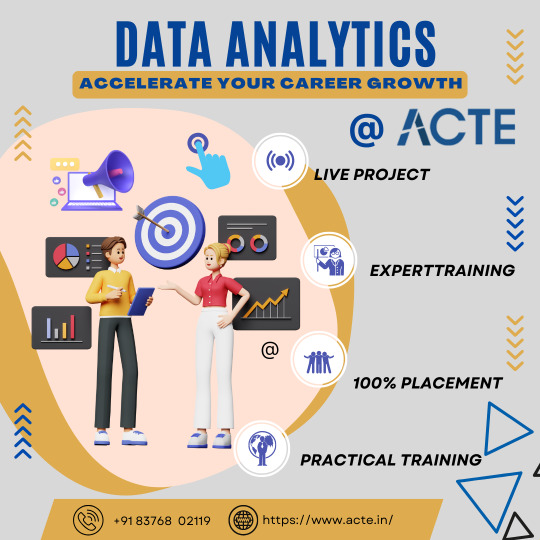
Data analytics is an exciting and profitable field that enables people and companies to use data to make wise decisions. You'll be prepared to start your data analytics journey by understanding the fundamentals described in this guide. To become a skilled data analyst, keep in mind that practice and ongoing learning are essential. If you need help implementing data analytics in your organization or if you want to learn more, you should consult professionals or sign up for specialized courses. The ACTE Institute offers comprehensive data analytics training courses that can provide you the knowledge and skills necessary to excel in this field, along with job placement and certification. So put on your work boots, investigate the resources, and begin transforming.
21 notes
·
View notes